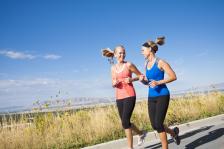What Should You Wear During Exercise?
Research shows that your clothes can actually affect your athletic performance. Get-Fit Guy helps you find the right fabrics for your next workout.
Ben Greenfield
Listen
What Should You Wear During Exercise?

Have you ever been out for a run or a workout at the gym and wondered whether you might be able to perform just a little bit better if you were wearing the right kind of fabric?
Perhaps that expensive shirt from the sporting goods store would somehow make you feel lighter than your old cotton t-shirt? Maybe wearing special socks would somehow make you last longer in your run than the random pair you grabbed from your drawer this morning? Is it possible that your choice of underwear is sabotaging your fitness goals?
The fact is, your clothing actually can affect your workout. A recent study in the Journal of Strength & Conditioning Research entitled “Synthetic garments enhance comfort, thermoregulatory response, and athletic performance compared with traditional cotton garments” looked into this very topic, assessing whether comfort, thermal regulation, and physical performance could be affected by the clothing that is used during physical activity.
In the study, a fitness test was performed while wearing protective padding. The protocol was completed on 2 occasions, once while wearing cotton clothing and again while wearing special exercise-specific polyester fabrics designed to transfer moisture and enhance cooling in a process referred to as “wicking.”
Compared to cotton clothing, the polyester garment provided significantly greater comfort in both men and women, and also improved performance and enhanced cooling. Here’s how the right kind of clothing can actually improve your performance:
Flexibility
If you’re a fan of yoga, or you play sports that require mobility and frequent changes-of-direction such as soccer, tennis, or football, then you should select exercise clothes that allow your joints the ability to go through their full range of motion. Exercise clothing made from polyester and spandex is stretchy and durable, and even though cotton blends can provide adequate movement, the cotton doesn’t breathe quite as well as alternative fabrics.
If you’re self-conscious about tight-fitting exercise clothes, wear stretchy fabrics as a base layer and add a baggy, easy-to-breathe layer on top.
Moisture Wicking and Cooling
Even for easy workouts, heat, perspiration and moisture can create uncomfortable problems. So if you know you’ll be exercising in the heat, or you’re heading to the gym to exercise in a stuffy indoor setting, you should look for tops and bottoms that wick away moisture.
Cotton absorbs moisture and can become uncomfortable very fast, whereas nylon and polyester fabrics do not. Most of the labels on exercise clothes will advertise whether or not the material is actually moisture-wicking, so do your research and make sure that any layer that is in touch with your body has the ability to transfer heat and moisture adequately.
Protection

The weather is something you’ll often need protection from too, so if you’re hiking or planning to be outside in the elements, wear layers of clothes that you can remove if you become too warm, preferably by starting with a base layer (against your skin) to manage moisture, then an insulating layer such as wool to protect you from the cold, and finally a shell layer (outer layer) to shield you from things like the wind and rain.
Reflection
Do you exercise in the early morning or evening hours? If so, you should consider investing in workout clothes that have reflective material which provides visiblity in the dark or in poorly lit areas. You may think that this means wearing light colors like yellow or white, but a better option is to choose a dark color like dark blue or black, and then look for clothing that has sewed in reflective panels.
Reflective paneling on both shoes and exercise clothes is actually quite common now and if you’re an early bird or a night owl exerciser, would be a good addition to your fitness wardrobe.
Health

Wool production also requires high levels of insecticides and antibiotics to protect animals from pests and disease. When you consider that pesticides have been shown to cause a big range of health problems such as headaches, fatigue, nausea, asthma, cancers, neurological disorders, and birth defects, it might be time to check out the source of the fabrics that you wear during exercise and to consider alternative sources such as hemp or bamboo. To learn more about organic clothing fabrics and options, I’d recommend you read this comprehensive guide from How Stuff Works.
So based on this, what is the best type of clothing to wear during your workout? Let us know what you decide and why at Facebook GetFitGuy.

